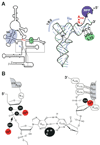Unexpected diversity of RNase P, an ancient tRNA processing enzyme: challenges and prospects
- PMID: 19931535
- PMCID: PMC2799185
- DOI: 10.1016/j.febslet.2009.11.048
Unexpected diversity of RNase P, an ancient tRNA processing enzyme: challenges and prospects
Abstract
For an enzyme functioning predominantly in a seemingly housekeeping role of 5' tRNA maturation, RNase P displays a remarkable diversity in subunit make-up across the three domains of life. Despite the protein complexity of this ribonucleoprotein enzyme increasing dramatically from bacteria to eukarya, the catalytic function rests with the RNA subunit during evolution. However, the recent demonstration of a protein-only human mitochondrial RNase P has added further intrigue to the compositional variability of this enzyme. In this review, we discuss some possible reasons underlying the structural diversity of the active sites, and use them as thematic bases for elaborating new directions to understand how functional variations might have contributed to the complex evolution of RNase P.
Figures


Similar articles
-
The RNase P family.RNA Biol. 2009 Sep-Oct;6(4):362-9. doi: 10.4161/rna.6.4.9241. Epub 2009 Sep 9. RNA Biol. 2009. PMID: 19738420 Review.
-
Bacterial RNase P: a new view of an ancient enzyme.Nat Rev Microbiol. 2006 Oct;4(10):729-40. doi: 10.1038/nrmicro1491. Nat Rev Microbiol. 2006. PMID: 16980936 Review.
-
Discovery, structure, mechanisms, and evolution of protein-only RNase P enzymes.J Biol Chem. 2024 Mar;300(3):105731. doi: 10.1016/j.jbc.2024.105731. Epub 2024 Feb 8. J Biol Chem. 2024. PMID: 38336295 Free PMC article. Review.
-
RNase P: interface of the RNA and protein worlds.Trends Biochem Sci. 2006 Jun;31(6):333-41. doi: 10.1016/j.tibs.2006.04.007. Epub 2006 May 6. Trends Biochem Sci. 2006. PMID: 16679018 Review.
-
Multiple structural flavors of RNase P in precursor tRNA processing.Wiley Interdiscip Rev RNA. 2024 Mar-Apr;15(2):e1835. doi: 10.1002/wrna.1835. Wiley Interdiscip Rev RNA. 2024. PMID: 38479802 Review.
Cited by
-
Messenger RNAs bearing tRNA-like features exemplified by interferon alfa 5 mRNA.Cell Mol Life Sci. 2015 Oct;72(19):3747-68. doi: 10.1007/s00018-015-1908-0. Epub 2015 Apr 22. Cell Mol Life Sci. 2015. PMID: 25900662 Free PMC article.
-
Discovery of a minimal form of RNase P in Pyrobaculum.Proc Natl Acad Sci U S A. 2010 Dec 28;107(52):22493-8. doi: 10.1073/pnas.1013969107. Epub 2010 Dec 6. Proc Natl Acad Sci U S A. 2010. PMID: 21135215 Free PMC article.
-
Alba-domain proteins of Trypanosoma brucei are cytoplasmic RNA-binding proteins that interact with the translation machinery.PLoS One. 2011;6(7):e22463. doi: 10.1371/journal.pone.0022463. Epub 2011 Jul 21. PLoS One. 2011. PMID: 21811616 Free PMC article.
-
Crystallization and crystallographic analysis of an Arabidopsis nuclear proteinaceous RNase P.Acta Crystallogr F Struct Biol Commun. 2015 Nov;71(Pt 11):1372-7. doi: 10.1107/S2053230X15017033. Epub 2015 Oct 23. Acta Crystallogr F Struct Biol Commun. 2015. PMID: 26527263 Free PMC article.
-
Simultaneous characterization of cellular RNA structure and function with in-cell SHAPE-Seq.Nucleic Acids Res. 2016 Jan 29;44(2):e12. doi: 10.1093/nar/gkv879. Epub 2015 Sep 8. Nucleic Acids Res. 2016. PMID: 26350218 Free PMC article.
References
-
- Guerrier-Takada C, Gardiner K, Marsh T, Pace N, Altman S. The RNA moiety of ribonuclease P is the catalytic subunit of the enzyme. Cell. 1983;35:849–857. - PubMed
-
- Evans D, Marquez SM, Pace NR. RNase P: interface of the RNA and protein worlds. Trends Biochem. Sci. 2006;31:333–341. - PubMed
-
- Gopalan V, Altman S. Ribonuclease P: structure and catalysis. In: Gesteland RF, Cech TR, Atlkins JF, editors. The RNA World. New York: Cold Spring Harbor Laboratory Press; 2006. only online at http://rna.cshl.edu.
Publication types
MeSH terms
Substances
Grants and funding
LinkOut - more resources
Full Text Sources
Other Literature Sources

